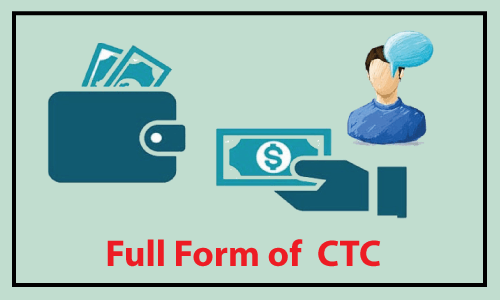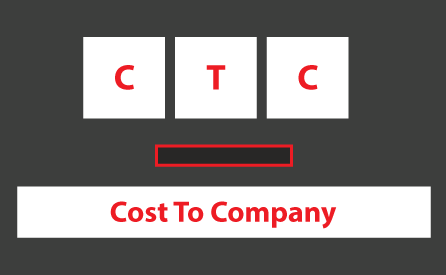Full Form of CTC
CTC (Cost to Company)

In this post, you can discover the abbreviation of CTC, a brief description, and its relevance in both work and organization.
CTC is the cumulative amount of the wage plan that the organization provides as jobs to display the total remuneration. CTC is a phrase used in several countries such as India, South Africa, Indonesia, etc., in this pay bundle.
CTC refers to the company's cost, which implies the cumulative value of an employee's prices to be paid by the corporation (or employer). These indicate the provided pay plan's cumulative value, plus per capita additional expenses, wages, and benefits.
Focused on the wages earned and including all the incentives and benefits over the worker's work duration, CTC is determined. For instance, assume the salary of a worker is INR 5,000, and he/she provides INR 2,000 medical benefits, then INR 7,000 is the total CTC.
Some special perks and incentives to staff can also be included by CTC, like free dinners, taxi services, house rentals, unintentional premiums, gas expenses, etc. Note, CTC, including all other compensation or incentives provided to an employee, is often assessed. It is not the pay provided by them.
Advantages from CTC -
The CTC consists predominantly of three factors: direct profit, indirect profit, and commitment to savings.
1) Direct incentives (direct benefits)
Direct benefits are named incentives that, alongside wages, are applied to the worker; such incentives are as follows-
- The Standard Salary
- Allowance of Transport
- Allowance of Age
- Allowance for Housing
- Allowance for Cars
- Allowance for Cell Phones
2) Indirect Advantages -
Indirect benefits refer to as the benefits earned by a worker rather than wages; such incentives are as follows-
- Interest-free borrowings, if any
- Owned Group Housing
- Investments in Income Tax
- Lease Office Room
- Voucher Produce, Free Meals
3) Contribution Expenditure -
Only after retirement from work were all those services open to the worker, the savings payments are as follows-
Company provident fund: most employers pay 12% (called PF) of basic wage to the pension scheme savings fund of workers per month, seen in CTC. Employees also allocate 12 percent to the (call VPF).
Gratuity is a CTC component: charged under Indian tax law at 4.81 percent of the gross annual minimum income, without any withdrawal permissible before five years. You forfeit your gratuity accumulation if you quit the company sometime within five years.
Superannuation: In your pension scheme plan, a pre-defined sum is deposited every month, often provided as a means to prepare for retirement by international corporations. Since you resign or at the moment of quitting the company, you will delete it. Most companies may not give you the money for a breakup explicitly, however. You have a chance to turn the number into another sort of insurance scheme.

CTC Stages
Gross salary of a CTC: The gross salary is the cumulative sum preceding income tax. The incentives provided to an individual as a pay scale for the entire financial year are the CTC's gross salary.
Salary Package: This CTC covers most of an individual employee's nominal and non-monetary costs. Along with wage, HRA (House Rent Allowance), fuel charges, regular expenditures, free meals, taxi services, etc., are combined in the kit.
In-hand salary: This is the sum of wages (in-hand) offered to workers, minus all the other monetary and non-monetary incentives. It is an individual employee's minimum wage.
For measuring CTC, the equation is,
CTC = GROSS wage + bonuses + other costs
It merely means that CTC is not just the wage and involves several items such as a dinner, medical equipment, telephone expenses, household services, pension, etc. In the CTC kit, several businesses, substantial financial institutions also include office space leases.
Besides, if your business gives you lodging, a vehicle, a driver, etc., the CTC would consist of these services' expenses. So, many of your CTC elements are not converted into real take-home dollars, and what you'll get In-hand still stays except for your CTC.
Individuals assuming that a raise in CTC, as seen in the offer letter, would raise the in-hand wage when moving jobs; however, there are different components of a CTC that impact your in-hand salary. A few of these elements pump up your CTC, and as a component of your monthly salary, you cannot get them.
Simple salary: Basic wage is a set part of your payment arrangement, and a portion with you in wage represents the total sum.
Allowances: There are several expenditures that the CTC can provide, aside from the regular wage. Examples are HRA, transportation, and leave allowance. Up to the amount, some of these deductions are tax-free, and several of them are contingent on actual expenses.
Claims: The paid claims can also make up a majority of your income. That includes items such as cellular reimbursement, medical allowance, etc. These elements have a daily cap set for them, and you can file the accounts to get a refund. These would be typically tax-free.
Deductions: Obligatory deductibles constitute a big part of the CTC. These include pension scheme reductions, life insurance, etc. They are part of your contract arrangement, but you don't get them as most of your in-hand pay. Even so, it would not raise your net salary, even if it increases your CTC.
Performance-related pay: Nowadays, linking a portion of the wage to performance and efficiency has become a norm. You get the maximum sum on 100% aim accomplishment, but it forms a part of your CTC, delicious it up.
Taxes: Taxes allow your wages to suffer more leaks. Taxes are an imminent injustice, and they take up a considerable chunk of your paycheck. Bid messages don't refer to Taxes.
The distinction between Payslips and CTC:
The CTC will provide several salaries/wage-added items, such as health insurance, insurance, lodging, transport, and amusement allowances. The Tax is withheld from the cash sum directly earned by the worker. Businesses use the word CTC to represent the average expense per employee (the principle of direct cost) from an organization's mindset. Unlike at CTC, all the money spent decreases the number of workers is distinct. The indirect expense will also be incurred and thus not counted in CTC, much as the price of electricity, supporting teams such as HR, IT, Management, etc. Therefore, no element that is not attributed to the worker is in the CTC.
What are the gross wage and CTC?
CTC versus Gross salaries.
CTC is during a given year, the sum that a worker would invest in an employee, while gross pay is that the sum a worker earns as a wage before all expenses.
Is CTC monthly or annual?
CTC includes monthly elements such as pay, additional payments, refunds, etc., and yearly materials such as gratuity, annual pay increases, performance incentives, etc. CTC is not sufficient for the amount of the employee's take-home salary.
Is CTC tax included?
The corporation views its overall money expended on you, specifically the CTC or expense to the firm. It means that there are parts of the CTC that are not in the tax viewpoint. CTC usually consists of Basic wages.
What is Annum CTC?
It's a worker's annual pay package. It shows the total expenses spent on a worker during a year by a corporation. Most organizations are now providing their wage only within the form of CTC.